Welcome to the new Traders Laboratory! Please bear with us as we finish the migration over the next few days. If you find any issues, want to leave feedback, get in touch with us, or offer suggestions please post to the Support forum here.

richbois
-
Content Count
89 -
Joined
-
Last visited
Posts posted by richbois
-
-
5 hours ago, FarridinK said:This is JOHN TAYLOR not George Douglass Taylor so this something completely different?
you are right nothing to do with TTT
-
ive been thinking about buying taylors book but ive seen a lot of bad reviews on amazon. i havent traded and im just learning, so i dont know much about the markets, but i was wondering if buying his book now is worth it, or if i should buy it after i start trading for a bit.the book is excellent but very hard to read
the method is as good today as it was in 1948
-
Im sure this has been brought up in one of the Taylor threads but I figured I'd ask in the most recent one. When determining the high and low for the day, are you guys using a 24hr timeframe or basing it on regular trading hours?As I have recently read through the Taylor material for a second time I am trying to start a book on crude oil but I am not sure whether I should use 24 hr data for the highs and lows or regular trading hours.
In the EBook that has Crude Oil, Nat Gaz, Gasoline , Heating Oil, Gold, Silver and Copper, I use 24 Hour data.
The only Futures that I compile both 24hr and Day session is for the Index Futures.
-
^^ How do you cross apply the MTP software with this analysis?first I must say that i dont you the MTP software the way they teach.
I use it for patern recognition and reversal bars.
In this case you had the previous day low as the most important clue. that is a gold making clue.
we had 2 ABC waves and if you took the 1st ABC as wave A and 2nd as C then wC = 227% of wA at 6254 area
if you took last ABC waves C= 227% of A at that same area
You also had the DP on 15 min just above
so for me (that believe in TTT) PL "Previous Low" is key and worth at least a quicky trade (scalp) .
I would have entered at 6256 area with a stop below 6253.50
In my trades i never trade 1 lot so with 2 lots i would take profit on the 1st lot at 2R
and run the 2nd lot as long as i could using the ATR or something like that.
It is funny you ask but I was talking with a customer at that time and discussing the same trade.
I hope i explained it properly
-
-
-
re TVGR I have a section in the Guide to trading TTT that covers TVGR with some examples. This section came about after a long period of watching daily gap on the US indices. I included a PDF of that section of the book. I know it has nothing to do with TTT but i find it a usefull tool.
re FDAX and TTT cycle. As Thales mentioned we can have a different cycle day for the same instrument and still need to trade it in the same manner. Mako had a SS day yesterday which made him look for shorts as the 3 day rally had culminated at the open.
In my case I had Monday as a Buy day. DAX had closed on the highs Friday, we could therefore expect the momentum to take it higher before that decline would start. In this case it had a huge gap up and that gap was above the SS Day high. In my statistics this is a must short at the first sign of reversal. In this case using Thales 1,2,3 method (if I understand it properly) this opportunity came at 9AM at the end of the 1st hour when we broke the low of the 1st 3min outside bar. That break also eliminated TVGR.
-
For me it means that based on the action of the previous day together with the relation of where we close on that action, and knowing what day of the cycle we are in, it does give you a bias or heads up on what to exoect the comming day.
Add the levels to that for additional ammunition.
wow my english is starting to looks like Taylor's :rofl:
-
(Has anyone applied TTT to weekly charts?)Great way to think and use TTT.
By the Way i tried to make a book using weekly data and it symply didnt work.
-
something that puzzelled me at first about TTT that I 'd like input on. Trading rules applied to an instrument or it's inverse (take etf's for example.... SPY vs SH or QQQQ vs PSG) should not contradict each other.So is it too simplistic to count an SS day as essentially a Buy day on the inverse index, a Buy day as essentially an SS day on the inverse index, and treat the day in between (S day in this case) as typically a transition day between SS and BU or vice versa?
It appears that taking into consideration the additional TTT rules (Buy day violations, opens below or above previous days highs or lows, etc., that this high level simplistic view would result in the fewest contradictions in the more specific rules day by day.
All thoughts welcome.
snowbird
Very interesting Question
This is one that any of us TTT user would have to decide by ourself. Dont forget that back in Taylor's days, there was no ETF's, the markets were just plain and simple. There was no globex session to complicate life and most in the US would find out that a crises happened in other parts of the world just few days later.
I am not even sure that there was futures on the Indices yes let alone the Spy or QQQQ.
Futures were mainly on commodities and that is a big part of what he was trading. Only pit hours. He also traded stocks and again that was only during pit hours no extended session.
I think he had it simpler than us but his system still works today.
To come back to your question, in my case since I found that the Positive 3 Day Ratio is a very important factor in establishing the cycle, I would use that to decide the cycle for SH or PSG.
In my trading books I have cash and Futures for FX. Euro for instance is on a different cycle and most would say that is impossible. But I have customers that use that to there advantage.
Either way as long as you trade what you see and follow the TTT rules it could be on the wrong cycle and you would probably to well. Reason is that most of us trade differently than Taylor. We are intraday Daytraders .
Have a great weekend
-
The above does actually resonate with me, if that bias actually gives one an edge.I know many traders will say that any bias is bad, but I often find that when I'm in the middle of a trade I will see a pattern, set of candlesticks, etc develop that will cause me to exit the trade short of my objective, only to see price rebound and continue on to the original target. I know this is due to my inexperience, but until I gain confidence I can see how a simple rule based on an edge that may indicate something like "longs only today" could be very powerful to me personally, which is one reason I'm interested in learning more about this.
snowbird
What is nice of using TTT is not only the bias, which will give you more confidence in that trade , but also the levels that are provided in the report. There is more than just the TTT levels. So if you managed to enter a trade at or close to the extreme for the day, you have an idea of what an average day should provide. This way you may let it ride longer. Also if you entered a trade late, you know that after X points of profits you should be protecting that profit and even considering closing that trade.
-
I am one of those Having said that I figured that if one was inclined they could probably condense things down to half a dozen (or less) pages of principles, tables and 'rules'. There seems to be a lot buried in text that could be fished out into simple tables and what not.
Having said that I figured that if one was inclined they could probably condense things down to half a dozen (or less) pages of principles, tables and 'rules'. There seems to be a lot buried in text that could be fished out into simple tables and what not.I tried to do that in my Guide to trading TTT
I need feed back on that so I can improve
-
Your comment on risk is intriguing. When studying a new idea or method, I often personally find it helpful to concentrate on the setups that present the highest probability or most fundamental application first, and learn this well so it becomes ingrained or second nature before moving on to the more subtle details. I think one of the reasons for the success of Thales thread is that he started with a simple basic 123 pattern.With Taylor, there appears to be so much to take in that many have abandoned the quest.
What have you found core to TTT that you would recommend a newbie to this method concentrate on first. (this question applies to all who have mastered or incorporated TTT in their own trading)
snowbird
Good question. What I have found about Taylor is that it is best used in conjonction with an other sysyem. For example If you use the simple 123 pattern, you will have a better chance of success if you are taking that trade in the direction that TTT is pointing that day, and even better if it happens at TTT levels.
Reading the original Taylor's book from Chapter 5 to 15 a few time will make you understand how to trade on each day of the cycle. Once you undestand that for example, on a Buy day you should only be looking to long except in this or that exception, then you will look for the right trade that day. Having said that, it doesnt mean I never take a trade that is in the opposite direction, however if I do, it will be only with smaller position and tighter stops and I will take or protect profit sooner.
The main purpose of TTT for me as a DAYTRADER, is to get a BIAS for the day, and Support and Resistance levels. These levels also help on the exit of the trade, because we know how far a normal move should take us, we can then either exit the trade or again protect the profits on that trade.
I hope that helped
-
OK,In regards to my last post, I did a search and found this comment from you last year in the TTT Thread.
"I do agree with you on what Taylor said, however in my discovery of the Positive 3 day cycle, I found that we can sometime Long on the SS day.
If the SS day opens below the Buy day low we do have very high odds of getting a rally to at least the Buy day low, at which point stops have to be tighten."
So in summary, there are cases where the price action of previous days would indicate a long on a SS day could be considered.
snowbird
You answered your own question. Yes that is one of the few cases where a long on SS day may be considered. However these trades are a bit more risky since the instrument opened below the BDL and that is bearish. But my statistics show that it is worth taking the long as mos of the time they will at least make a college try to get back to BDL.
As we can see yesterday OIL made it but barely.
I personnaly didnt think it would make it all the way yesterday because of the large ground to cover, but hey they made it
-
Hi All
I Posted 2 nice TTT examples on the other thread one on TF and one on OIL
-
-
-
Looking at the EURUSD chart and today being a SS day, We have just concluded a near perfect textbook 3 day cycle. Mar 15 the Buy day concluded the decline and started the rally as per TTT. Mar 16 continued the rally and started to consolidate. Mar 17 we get the last bit of rally and the decline starts all over again.
Now tomorrow should continue some decline before the rally can begin. Having said that we already have a decline in place but based on averages it should go lower.
So far we have a 50% retracement. Will see what tomorrow brings
-
Rich, I'm not asking you to post real time subscription data or that you do it on a regular basis.I am just trying to understand how you go from your statistical data you provide to the charts and trade planning from your point of view. If you could show for example, the CL data you provided last night along with how you would use the various data points provided in trade anticipation, that would work.
Provide whatever you feel comfortable with, I'm just trying to better understand how to use what you provide and then determine if that compliments the setups I trade.
I trade oil (CL).
Ok last night I was talking with a potential customer that was asking me my opinion on CL for today.
My answer was that we should get a rally and that my goal would be 1st the TTT PH line (previous day high) at 81.31 and that based on my 2 different types of averages for a Sell day rally we should get to between 81.44 and 83.32.
Well that is great prediction but if you were not long at yesterday's lows what do we do.
At the end of the day tomorrow CL made a nice ABC pattern and reversed. That would be what I would hope for if I missed my entry on the Buy Day Low.
Now if you were not sleeping
 you had a chance to enter during the night. We had the 78% retracement of the last push up and that was in the DP zone of the wave B. The DP zone is the green box on the chart. It was also between 300-327% extension on this wave down.
you had a chance to enter during the night. We had the 78% retracement of the last push up and that was in the DP zone of the wave B. The DP zone is the green box on the chart. It was also between 300-327% extension on this wave down.So that would have been my entry and would have been looking for the targets mentioned before.
In the case of my potential customer He was long allready so I hope he took his profit at the target zone.
-
Great summary post there Rich. Thanks. I am getting more familiar with the ideas here. Making the jump from this idea to your nightly statistical data is where I get some more confusion. If you can put together a post which shows the specific data you provide and how that can be used or not used that would also be helpful.Thanks.
Sorry but it is had for me to guess who is who i the world of nicknames.

Please tell me which instrument you want me to talk about
Also I cant do that on the forum all the time as it would'nt be fair to the paying customers if I post all the levels here all the time, but i will try
-
Absolutely the idea of anticipation still needs to be separated from the belief in prediction.You still clearly need to wait for the actual trigger, that you anticipate COULD happen.
Interestingly enough this could still be used in longer term trend trading (discretionarily applied as opposed to purely systematic), as it could probably help improve entries, and possibly minimise some slippage, and whipsawing stops.
(I actually find I sleep better with my longer term positions, the shorter term trading recently has my brain ticking over way too much at present..... and big boys....that brings up whole other connotations.
 )
)thanks.
Yes I have used TTT to enter long term positions in stocks. Once you know where the Buy day is then it does give you a bit of an edge in getting in at or near the low of the cycle. Then if the stock is actualy in a long term bullish mood then it is easy to stay in.
Or the other solution is you play part of the Big Boys game. For exanple you buy 200 shares of XYZ then sell 100 at the top of this cycle and rebuy that 100 on the next buy day. The only reason for keeping the 1st 100 shrs is in case XYZ is very bullish and only makes a shallow decline and you miss the re-entry.
There is lots of tricks in playing stocks compare to futures due to the leverage factor.
-
Thanks Rich,in terms of the names I guess then they key to remind ourselves is that we wish to align ourselves with the manipulators and not the masses. So we need to put ourselves in their shoes I guess. (my suggestion of renaming was not to change anything but to help give me the "aha" moment)
I think that this alignment causes issues with many traders as this I implies a bit of anticipation and targeting which is always something people warn against, with sayings such as - you cant predict the future. So we all wish to react, and read the market rather than anticipate it.
However by aligning ourselves with what the market is actually doing - in terms of a cycle - then we are listening to the cycle and going with the cycle - rather than just blindly watching and reacting.
The other thing I have always rallied against is the name a market manipulator - always has negative connotations. Would it be considered similar to thinking that they are just the big players - the market movers/the big volume. (I hate the use of the word smart money)
(always interesting for me, coming from some longer term trend following to where I always say "I have no idea where the market will get/go to, I just let the market take me for the ride", as opposed to trying to short term trade the mini trends)
I usually use the name Big Boys myself, but in the explanation above I used Taylor's words just to drive the point home.
TTT is a form of antipition but not at the extent of predicting the future. TTT gives us an idea of what may/should happens the next day together with some levels where this turn my occur. Taylor would then look at the ticker tape and watch the action in order to confirm the move.
Taylor was very strong at tape reading.
In today's world we have charts with different time frames to help us in this tape reading.
Therefore with the tools that you currently use to trade, TTT is there to help you be first on the side of the Big Boys and than the levels come into the picture.
I find that TTT does help the Day Trader since the trade doesn't last more than 36 hours in principle. As a Day trader on indices, most of us are out by the close. As far as FX and Commodities then yes trades may last 24-48 hours depending of the move and how good was your entry. I my case I sleep better when in cash.

-
I must agree with you all about the confusion about the name of the days.
However I am trying to keep it the way Taylor designed it.
There is a reason for the names for each day.
The premise is that the markets are manipulated.
The Buy day is day 1 of the cycle. In order for them (manipulators) to buy they must take the price down to a level that is acceptable to them. This is done on the SellShort day and ends on the Buy day.
So, in the perfect world, the low should be made early on the Buy day and then a rally begins. Once they start the ball rolling they expect the masses to keep pushing the prices up.
The goal is normally reached by the end of the Sell day, where they unload their positions.
At this point the masses are still pushing the prices up on the 3rd day called the SS day (SellShort Day), and who is selling to the masses ??? Yes, the manipulators. At this point there is no more buyers and the price starts to drop, therefore making a perfect SS day.
By the way, they usually cover their positions before the close of the SS day.
At this point, the masses are catching up and going short - on the start of the Buy day. This is when the manipulators are accumulating their long positions.
So, all this explains why the Names exist. In a perfect world we buy on Buy days , Sell on the Sell day highs, and Sell Short on the SS day. etc.
Since Taylor wrote his book in 1948-50 the trading world changed because of the computers.
And secondly the world of trading is not perfect.
Now let’s take today's GBPUSD example. The markets closed Friday on the SS day highs. We know we need a decline on Buy days. So if the decline is not accomplished on the SS day then it is delayed to the Buy day. Either way at some point, on the Buy day, there will be the Buy Day low. That is the start of the cycle and the place to buy.
Firstly, we need to concentrate on the previous day's action. The high, the low, and the close.
The High or the Low will be the 1st place of battle. Based on the type of day that we are expecting, we should be able to anticipate which will be battled first. On GBPUSD Friday’s close was near the highs, so therefore that should be the 1st place to be tested. We know that today is a Buy day, so the test should fail in order to get a decline. As this happened, that was the place to short until the Buy Day Low is in place.
Then the word BUY starts to make sense.
The main difference between us and Taylor is that now markets are open 24 hours a day, and most of us are intraday traders.
I hope i made some sense of all this.
-
I just posted on this thread, a great way to trade TTT on a Buy day. This was on GBPUSD today.

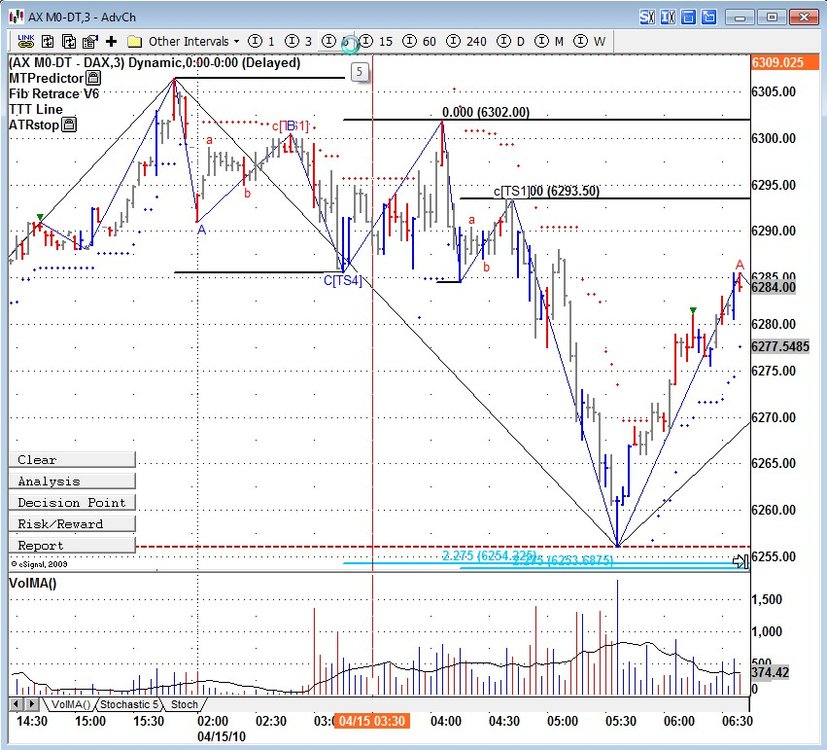
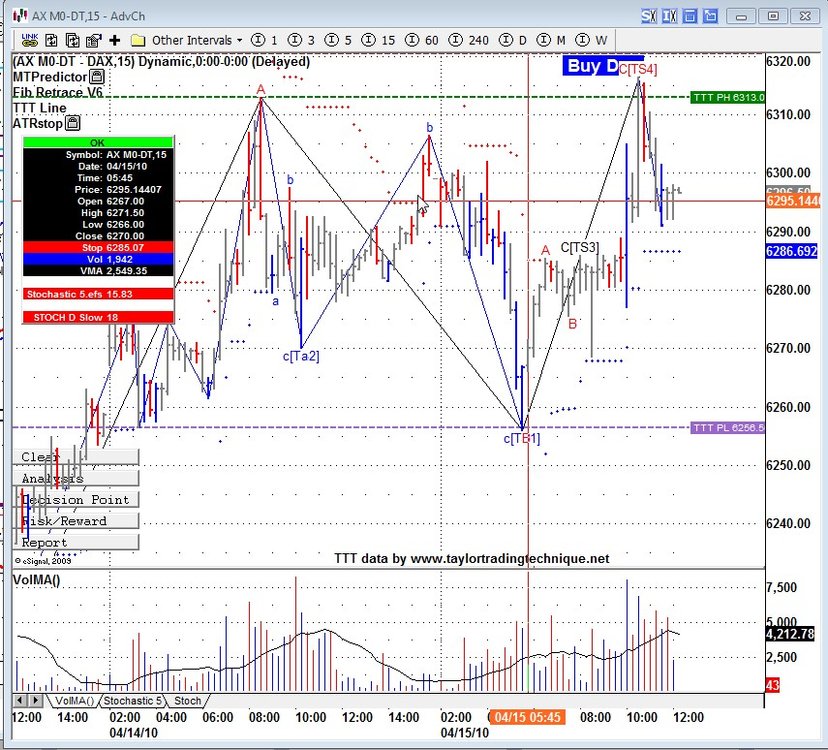
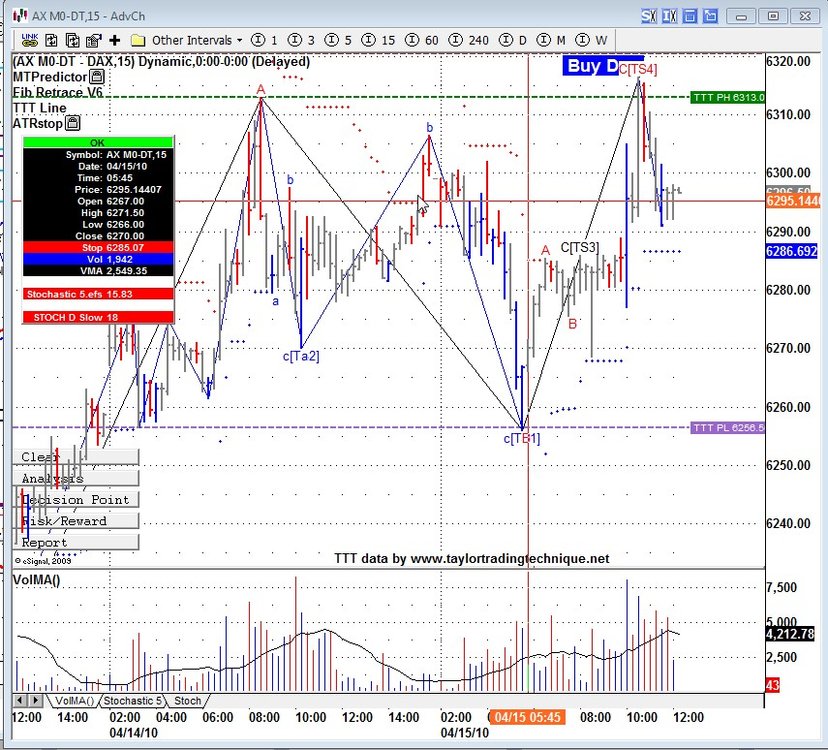
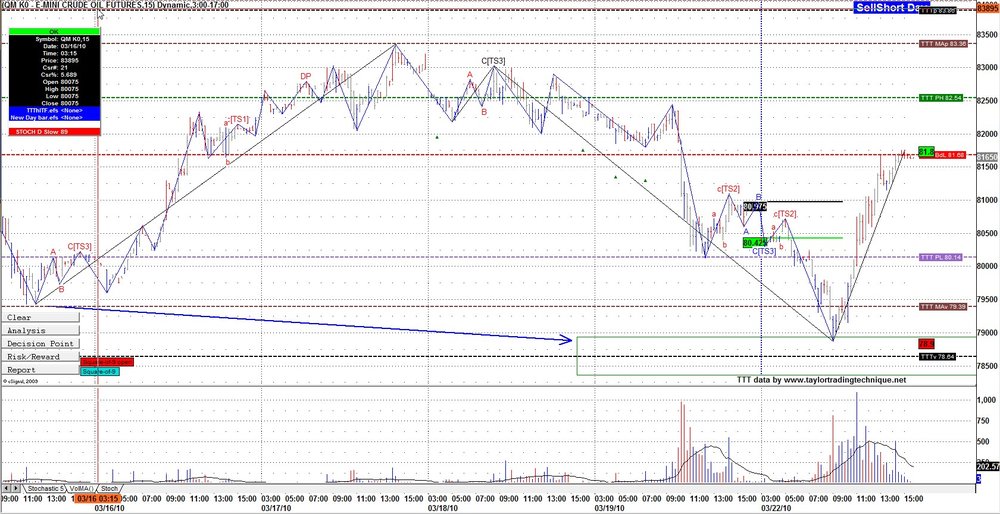
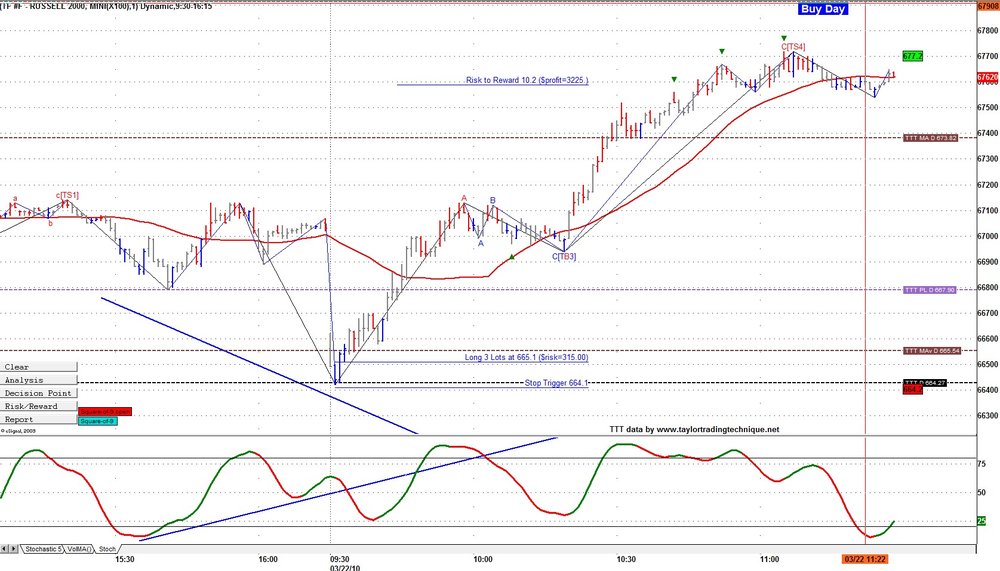
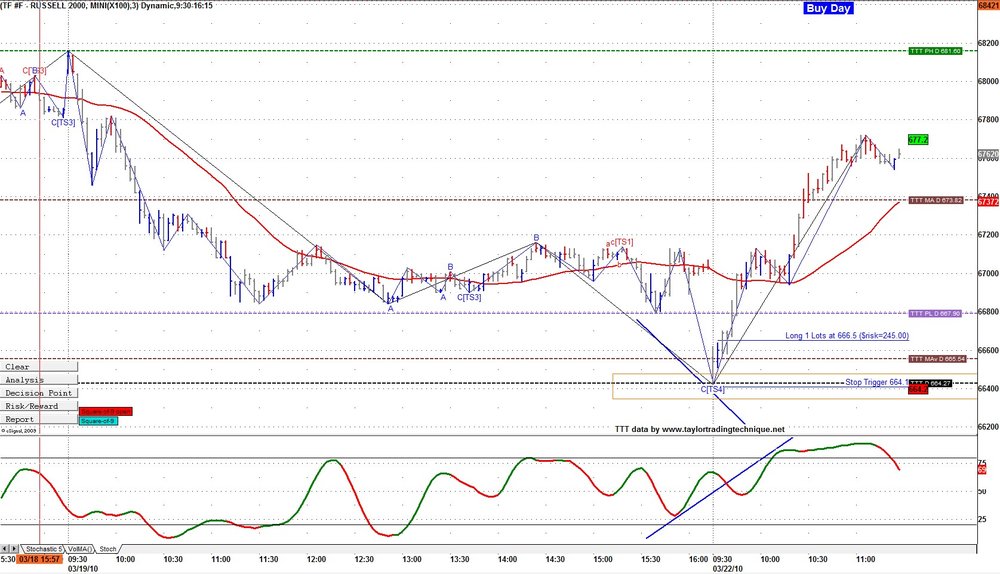
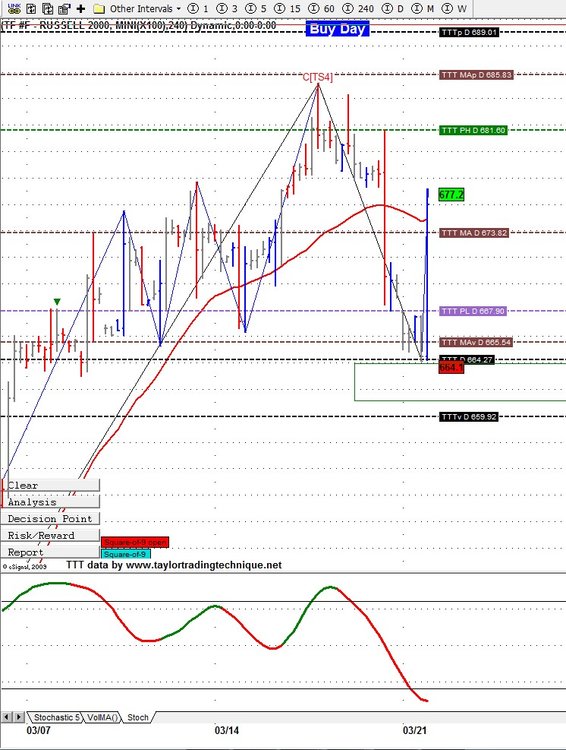
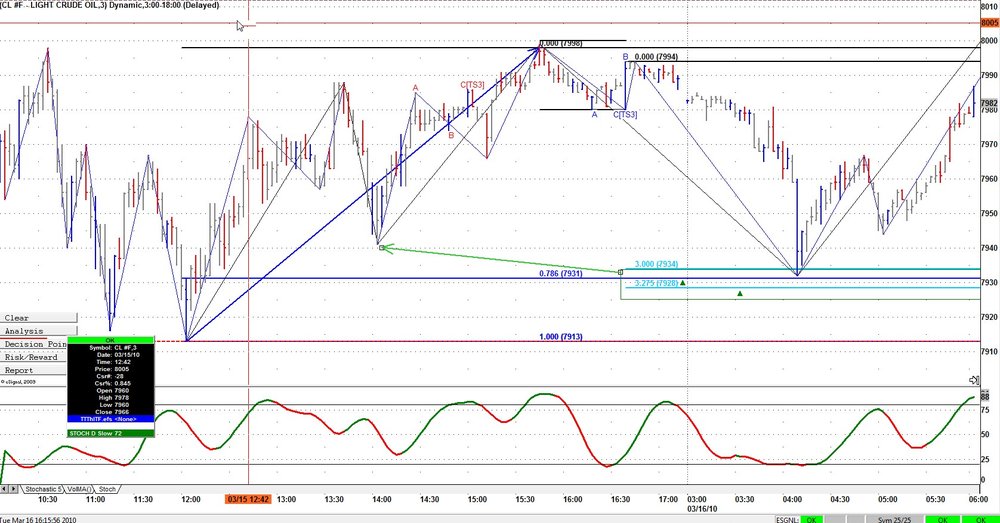
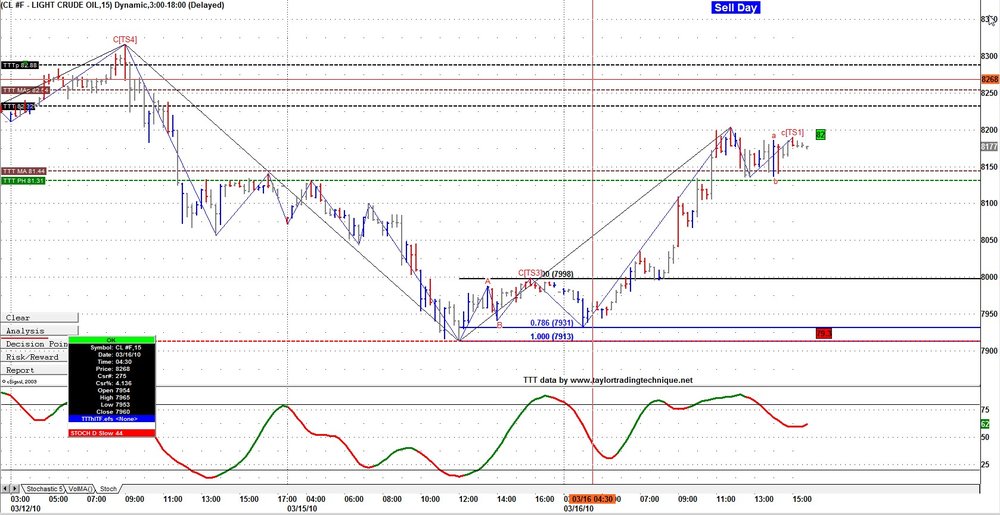
Taylor Trading Technique
in Swing Trading and Position Trading
Posted
I am probably to only Pure TTT guy out there. After 10 years of doing Taylor i still dont beleive in changing the cycles when it dont suit you. Exact Entries and Exit are not really part of the Taylor method. This method gives you guide lines. My system has improved over the years and added Ranges and Standard Deviations to the basic method.
Taylor used daily date to calculate his ranges and targets for the next day. Believe it of not it still works after 70 years. The intraday data is used for entry and exit . Yes it is not evident but that comes with experience. I find that trading stocks with TTT is very hard, Futures are easier. I guess you could use Future levels to trade CFD's but i havent tried thatInsert other media
Richard TaylortradingTechnique.com